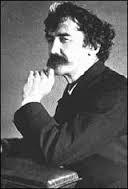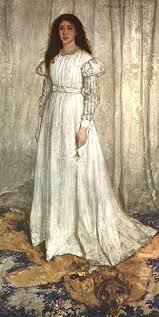I've always had a soft spot in my heart for James McNeill Whistler. I first encountered "The White Girl," a stunning mélange of innocence and sensuality, at the National Gallery of Art here in Washington a few years ago, and was instantly mesmerized.
I made a dash for the gift shop, and found a print of the painting, which now has a proud place above a dresser in my bedroom.
Since then, I've steadily collected more information about Whistler, his prickly persona and tempestuous life. If he were alive today, I believe he'd be a more elegant version of Perez Hilton, always picking fights with celebrities and socialites. As someone put it quite charmingly the other day, "he'd be the first major artist on Twitter."
Whistler was famous for marking his pieces with a butterfly with a stinger tail, a fine allegory for his personality.
Among the recipients of his sting was Oscar Wilde with whom he crossed paths in Paris Café society, and the art critic John Ruskin, whom he sued for libel.
Another famous falling out was with Gustave Courbet, allegedly after Whistler's lover, Joanna Hiffernan, the model for "The White Girl," posed for Courbet's L'Origine du monde.
The backstory to one of Whistler's most infamous catfights is the inspiration for a new installation at the Freer Sackler Gallery.
In late 19th century London, Whistler befriended the arts patron Frederick Leyland, who commissioned Whistler to makeover his dining room while Leyland was on holiday.
When Leyland returned, he was horrified by Whistler's work , what today is known as "The Peacock Room," as it is covered in rich shades of gold, blue and green.
Adding insult to injury was the fact that Whistler, a self-promoter of some renown, had invited friends and members of the press to loiter at the house, watching him paint.
Leyland refused to compensate Whistler, deeming his work and behavior outrageous, but allowed the indignant Whistler to at least finish the job.
Whistler topped off the room with a mural depicting two bickering peacocks, calling his work "Art and Money."
"That confounded Peacock Room has nearly ruined me, " Whistler is known to have said. He went bankrupt in 1879.
For whatever reason, Leyland left the room as Whistler painted it, and after Leyland's death in 1892, the room fell into the hands of Charles Freer, a wealthy industrialist. In 1904, Freer had the room taken apart, shipped and reassembled for his Detroit home.
Since 1923, the room has been on display in the Freer Gallery in Washington.
Opening on Saturday, May 16, is artist Darren Waterston's "Filthy Lucre," a reimagining of the room, a metaphor for the deterioration of a friendship, the constant tension between art and money.
A larger exhibition informs visitors of the history of the friendship and its downfall.
A video presents letters and telegrams between the two men. Visitors can see portraits Whistler did of Leyland, one handsome and dignified, while they were friends, the other called "The Gold Scab, " interprets Leyland as a monstrous figure, grasping for money and status.
Our 2024 Coverage Needs You
It's Another Trump-Biden Showdown — And We Need Your Help
The Future Of Democracy Is At Stake
Our 2024 Coverage Needs You
Your Loyalty Means The World To Us
As Americans head to the polls in 2024, the very future of our country is at stake. At HuffPost, we believe that a free press is critical to creating well-informed voters. That's why our journalism is free for everyone, even though other newsrooms retreat behind expensive paywalls.
Our journalists will continue to cover the twists and turns during this historic presidential election. With your help, we'll bring you hard-hitting investigations, well-researched analysis and timely takes you can't find elsewhere. Reporting in this current political climate is a responsibility we do not take lightly, and we thank you for your support.
Contribute as little as $2 to keep our news free for all.
Can't afford to donate? Support HuffPost by creating a free account and log in while you read.
The 2024 election is heating up, and women's rights, health care, voting rights, and the very future of democracy are all at stake. Donald Trump will face Joe Biden in the most consequential vote of our time. And HuffPost will be there, covering every twist and turn. America's future hangs in the balance. Would you consider contributing to support our journalism and keep it free for all during this critical season?
HuffPost believes news should be accessible to everyone, regardless of their ability to pay for it. We rely on readers like you to help fund our work. Any contribution you can make — even as little as $2 — goes directly toward supporting the impactful journalism that we will continue to produce this year. Thank you for being part of our story.
Can't afford to donate? Support HuffPost by creating a free account and log in while you read.
It's official: Donald Trump will face Joe Biden this fall in the presidential election. As we face the most consequential presidential election of our time, HuffPost is committed to bringing you up-to-date, accurate news about the 2024 race. While other outlets have retreated behind paywalls, you can trust our news will stay free.
But we can't do it without your help. Reader funding is one of the key ways we support our newsroom. Would you consider making a donation to help fund our news during this critical time? Your contributions are vital to supporting a free press.
Contribute as little as $2 to keep our journalism free and accessible to all.
Can't afford to donate? Support HuffPost by creating a free account and log in while you read.
As Americans head to the polls in 2024, the very future of our country is at stake. At HuffPost, we believe that a free press is critical to creating well-informed voters. That's why our journalism is free for everyone, even though other newsrooms retreat behind expensive paywalls.
Our journalists will continue to cover the twists and turns during this historic presidential election. With your help, we'll bring you hard-hitting investigations, well-researched analysis and timely takes you can't find elsewhere. Reporting in this current political climate is a responsibility we do not take lightly, and we thank you for your support.
Contribute as little as $2 to keep our news free for all.
Can't afford to donate? Support HuffPost by creating a free account and log in while you read.
Dear HuffPost Reader
Thank you for your past contribution to HuffPost. We are sincerely grateful for readers like you who help us ensure that we can keep our journalism free for everyone.
The stakes are high this year, and our 2024 coverage could use continued support. Would you consider becoming a regular HuffPost contributor?
Dear HuffPost Reader
Thank you for your past contribution to HuffPost. We are sincerely grateful for readers like you who help us ensure that we can keep our journalism free for everyone.
The stakes are high this year, and our 2024 coverage could use continued support. If circumstances have changed since you last contributed, we hope you'll consider contributing to HuffPost once more.
Already contributed? Log in to hide these messages.



